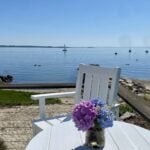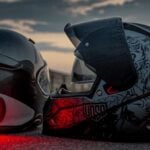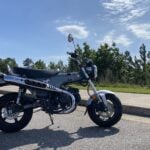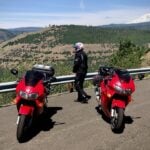A tire equally at home on the track and the street
In fall of 2022, Dunlop introduced the Q5 and Q5S to replace the Q3+ and Q4 as their top tier trackway and fast street tires. Dunlop junkies rejoiced as the track focused Q5 and streetable Q5S provided race day levels of grip without the hassle of tire warmers. I took a set of Q5Ss to The Ridge Motorsports Park in Shelton in spring of 2023, typical early summer stop of the MotoAmerica series. I loved their quick warm up time and raved about their edge grip. Dunlop tire engineers- unlike me in school- definitely did their homework.
I wondered how the stellar Dunlops would perform long term as both a street tire and trackday weapon. The Q5S tires have a harder center compound for street mileage so I kept them on my Honda Superhawk for the duration of the 2023 riding season for commuting, touring and canyon sprint miles, using them as most riders would for a whole year. Then recently, after a full year with the tires on the bike, I returned to MotoAmerica’s early summer race venue, The Ridge Motorsports Park in Shelton, Washington for a second thrashing to see how they would fare after a full season of use.
Sixteen turns in about 2.5 miles means no place to rest. The Ridge is physically demanding and technical.
The Ridge Motorsports Park on Washington State’s Olympic Peninsula lives among the scenic pines and greens in full view of Mt. Rainier. It is beautiful, technical, wide and the opposite of a flowing track. There are four totally blind and weightless corners to sap front end grip, an endless left hand carousel, a Laugna Seca-like corkscrew 50 foot plunge featuring the slowest corner on the MotoAmerica circuit followed by a half mile front straight. To slow down top speeds, The Ridge implements a chicane on the front straight and we would be using it for our sessions. If a tire has a weakness, it appears somewhere along this 40 foot wide torture chamber and it’s 400 feet of elevation changes.
Majestic Mt. Rainier and the surrounding forest makes The Ridge Motorsports Park one of the most scenic rounds of the MotoAmerica circuit.
Weather was perfect for the day with temperatures in the 60’s, mixed clouds and a light breeze, so based on past experience I dropped tire pressures to 30 psi front and 31 psi rear. On the out lap of my first session, I gave the Dunlops a lap to gradually work up to temperature, and one lap was all they needed.
Just as before, even after a full year of use, the Q5S had nimble handling allowing for quick left-right transitions through the chicane. Their edge grip was sure and predictable meaning outside passes on the carousel were once again my go-to passing maneuver. Normally this is a dicey confidence move since it means being off the racing line and carrying more speed to make up for the extra distance traveled. However, I had the grip and feel to pull it off lap after lap.
Turn 13, the slowest corner on the MotoAmerica circuit, is a first gear turn followed by a 50 foot drop which the Dunlops handled lap after lap. Later in the afternoon they finally started to show signs of fatigue.
Also, edge grip meant I was able to get on the gas sooner for ridiculous exit drive, especially leaving the decreasing radius turn 11 where I made many passes on the short sprint to turn 12. Dunlop’s Q5S, even after a full trackday and one full riding season on the bike still had levels of grip that made other riders shake their heads as I passed them around the outside- on street tires, with no tire warmers, on a 25 year old motorcycle with no engine maps, no active suspension and no quick shifter.
And carburetors. What are those?
After my first session was over I got off the Superhawk, checked the tires and just shook my head, amazed at the Dunlops. I resolved then and there to only put Q5S rubber on my Honda Superhawk.
Sessions ran into the afternoon while I upped the pace to high-intermediate times. I got passed just once all morning by a rider with a number plate running slicks. That was it. Then, after lunch, things changed.
The long time spent on the right hand side of the tires on turns 8a through 10 is where the Dunlops started to cry uncle.
On my first session after lunch, I noticed some degradation. Turns 8a through 10 are all right hand sweepers ending with a blind approach to the heavy braking decreasing radius turn 11. As the bike was on its right side, the rear gave way to shudder. Grip was still there, but the tire was talking to me, telling me that the limit was near. After applauding myself for finally pushing the Dunlops to the edge, I also applauded the Dunlops for being so communicative. The feel of the rear beginning to give was predictable and controllable, exactly what you want a tire to do when you are at full lean at triple digit speeds approaching a blind crest. I adjusted by slowing the rate of my throttle roll-on and tried to focus more on using my body to get the bike as upright as possible and get it on the meat of the tire. I was still turning good laps, but the Dunlop rear was finally starting to lose just that last 5% of its limit.
Then, approaching turn 13, the slowest corner on the MotoAmerica circuit that starts the 50 foot plunge to the front straight, the front started to push. Again, it was predictable, and I just backed up my braking marker and focused more on smooth initial brake application to load the front better. The front pushed again on the approach to the chicane on the front straight, but adjusting my braking marker and smoother brake application made the difference. The Dunlops were finally showing signs of their thrashing. It was about time.
Photos show the difference in wear after the first and second trackdays. Feathering on the outside of center on the second photo shows evidence of where the Dunlops spent a lot of time.
I did some homework. By then the Dunlops, at the end of their second trackday, had done over 120 laps around The Ridge Motorsports Park at full tilt boogie. That is a massive amount of abuse sustained by any tire. However, it’s not just the amount of laps; it is the heat cycling. Dunlop’s Q5S had to go from full cold, to track temperature, then back to cold, then back up to temp over and over again and still be able to perform at track level grip with no tire warmers. How Dunlop built this into their tire I have no idea, but these tires have my full confidence. And keep in mind I am running the street version with a harder center compound. The Q5 has no such harder center and would likely be a better choice for multiple trackdays.
These tires might hold up to a third trackday, but I would only do it for testing purposes. Until then, I will run them on the street for another riding season to see how they perform, and when it comes time to replace these tires, I am spooning on another set of Dunlop Q5S.
Because, unlike me, Dunlop engineers are good at their homework.
Very good.
Ted
*Photos by G. Powers Photography
Doing my homework. Finally.































0 Comments